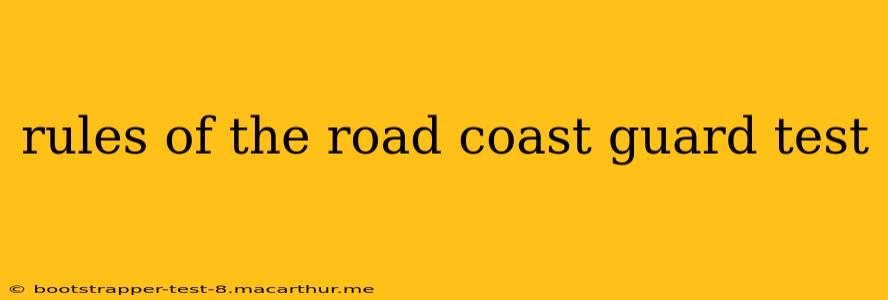Navigating the waters safely requires a solid understanding of the Rules of the Road, also known as the Navigation Rules. Passing the Coast Guard's exam on these rules is crucial for obtaining your boating license and ensuring safe navigation. This guide will break down the key aspects, addressing common questions and providing valuable insights to help you ace your test.
What are the Navigation Rules?
The Navigation Rules, as codified in the International Regulations for Preventing Collisions at Sea (COLREGs), are a comprehensive set of international maritime regulations designed to prevent collisions and ensure safe navigation. These rules cover everything from proper signaling procedures to the actions required when encountering other vessels in various situations. Understanding these rules is paramount for every boater, regardless of experience level.
Key Topics Covered in the Coast Guard's Rules of the Road Test
The Coast Guard test covers a broad range of topics within the Navigation Rules. Expect questions on:
-
Lights and Shapes: Understanding the meaning of various lights displayed by different types of vessels at night, as well as the shapes used during the day to indicate a vessel's status. This includes understanding the difference in lights for power-driven vessels, sailing vessels, vessels at anchor, and vessels restricted in their ability to maneuver.
-
Sound Signals: Knowing the various sound signals used by vessels to indicate their actions and intentions, such as fog signals, danger signals, and passing signals, is crucial.
-
Right-of-Way Rules: This is arguably the most important section. Mastering the rules of precedence, including who has right-of-way in various situations (e.g., head-on situations, crossing situations, overtaking situations), is essential for safe navigation and avoiding collisions.
-
Restricted Maneuverability: Understanding the special rules and considerations for vessels restricted in their ability to maneuver, such as fishing vessels, vessels engaged in underwater operations, or vessels towing other vessels, is vital.
-
Narrow Channels: Knowing the proper procedures for navigating narrow channels, including keeping to the appropriate side and maintaining safe distances from other vessels, is critical.
-
Meeting and Passing Situations: These rules clearly define actions to take when encountering vessels head-on, crossing, and overtaking, and how to avoid collisions in each scenario.
-
Distress Signals: Familiarizing yourself with various distress signals, both visual and sound, is essential.
What are some common mistakes made during the Coast Guard Rules of the Road test?
Many individuals struggle with the nuances and complexities of right-of-way rules. Memorizing the rules isn't enough; understanding their application in various scenarios is vital. Another common mistake is overlooking the importance of proper lookout and situational awareness. While the rules provide a framework, sound judgment and careful observation are equally crucial.
How can I effectively study for the Coast Guard Rules of the Road test?
Effective preparation is key to success. Here's a study strategy:
-
Use Official Resources: The Coast Guard Auxiliary and other boating safety organizations offer study materials and practice tests. Use these resources as your primary guide.
-
Practice, Practice, Practice: Take numerous practice tests. This will help identify your weak areas and reinforce your understanding of the rules.
-
Visual Aids: Diagrams and illustrations can significantly aid in understanding the rules, especially those related to lights and right-of-way.
-
Understand, Don't Just Memorize: Focus on understanding the underlying principles of the rules, rather than simply memorizing them.
-
Simulate Real-World Scenarios: Imagine different navigation situations and apply the rules to determine the correct course of action.
What is the format of the Coast Guard Rules of the Road Test?
The test typically consists of multiple-choice questions covering all aspects of the Navigation Rules. The number of questions and the passing score can vary, so check your specific state's requirements.
How many questions are on the Coast Guard Rules of the Road test?
The number of questions on the Coast Guard Rules of the Road test varies by state and testing location. It's typically a multiple-choice exam, and the specific number of questions should be confirmed through your state's boating safety education program.
What resources are available to help me study for the Coast Guard Rules of the Road test?
Numerous resources are available, including official Coast Guard publications, online study materials, and boating safety courses offered by various organizations. Consult your state's boating safety program for specific recommendations and approved study guides.
By diligently studying these rules and practicing their application, you can confidently pass your Coast Guard Rules of the Road test and navigate the waters safely and responsibly. Remember that boating safety is everyone's responsibility.
